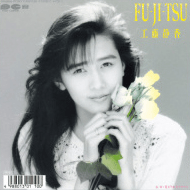Fu-ji-tsu
"Fu-ji-tsu" (stylized as "FU-JI-TSU") is a song recorded by Japanese singer Shizuka Kudo for her eponymous second studio album, Shizuka. It was released on June 1, 1988 through Pony Canyon as the album's leading single. The song was written by Miyuki Nakajima and composed and produced by Tsugutoshi Gotō.[1] This collaboration with a respected singer-songwriter like Nakajima, as well as Kudo's overall shift in image, were seen as a catalyst for the end of the 1980s idol phenomenon, with Kudo's career path being regarded as the blueprint for the successful transition from idol to artist.[2]
| "Fu-ji-tsu" | ||||
|---|---|---|---|---|
 | ||||
| Single by Shizuka Kudo | ||||
| from the album Shizuka | ||||
| Released | June 1, 1988 | |||
| Genre | ||||
| Length | 3:48 | |||
| Label | Pony Canyon | |||
| Songwriter(s) | ||||
| Producer(s) |
| |||
| Shizuka Kudo singles chronology | ||||
| ||||
| Audio sample | ||||
"Fu-ji-tsu"
| ||||
Background
When Kudo's solo debut was in the works, she was asked by then-Pony Canyon music executive Yūzō Watanabe to choose which singer-songwriter, out of Yumi Matsutōya, Mariya Takeuchi and Miyuki Nakajima, she preferred.[2] Kudo chose Nakajima, whom she was a big fan of.[2] This story, which had been floated around at the time as a sort of urban legend of the music industry, actually took place and shortly thereafter Nakajima was writing songs for Kudo.[2] "Fu-ji-tsu" marks the first collaboration between Nakajima and Tsugutoshi Gotō, who are often cited as the "golden duo" behind many of Kudo's hit singles.[3]
Composition
The song was written by Miyuki Nakajima and Tsugutoshi Gotō. It is composed in the key of B minor and set to a tempo of 136 beats per minute.[4] Kudo's vocals span from A3 to B4. The title of the song, which loosely translates to "Untruth", was written in roman letters because Nakajima felt that the kanji for "fujitsu" (不実) was too heavy for the then-18-year-old Kudo to be singing about.[5] Hyphens were added to the title in order for the song not be confused with the IT company Fujitsu.[5] Lyrically, the song describes the feelings of two former lovers who pretend not to know each other, or tell "untruths", in the presence of their new respective significant others.[6]
Critical reception
Kudo received acclaim for her vocal performance. Her voice was cited as "well-matched" to the melancholy melody of the song. "Fu-ji-tsu" is considered by critics to be the song that established Kudo as Akina Nakamori's successor to the pop crown.[7] Upon hearing Kudo perform her lyrics on the television show Uta no Top Ten for the first time, Nakajima phoned in during the show as special guest and described Kudo's delivery of her lyrics as "giving it a greater than life image unlike what I had initially imagined."[5] She added that, for that reason, she was glad to have offered the song to Kudo instead of keeping it for herself.[5]
Chart performance
"Fu-ji-tsu" debuted at number-one on the Oricon Singles Chart, with 60,000 copies sold, becoming Kudo's first number-one debut since "Kindan no Telepathy".[8] The song was recognized by Oricon as the second best-selling single of June 1988, edged out from the top spot only by Akina Nakamori's "Tattoo".[9] The single charted for a total of twenty weeks. It became the first of eight consecutive number-one songs on the Oricon Singles Chart for Kudo.[2]
Track listing
All music is composed by Tsugutoshi Gotō.
| No. | Title | Lyrics | Arranger(s) | Length |
|---|---|---|---|---|
| 1. | "Fu-ji-tsu" | 3:48 | ||
| 2. | "Natsu ga Kureta Miracle" (夏がくれたミラクル, Natsu ga Kureta Mirakuru, "A Summer Miracle") |
| 3:56 | |
| Total length: | 7:44 | |||
Charts
| Chart (1988) | Peak position |
Sales |
|---|---|---|
| Japan Weekly Singles (Oricon)[10] | 1 | 253,000[11] |
| Japan Monthly Singles (Oricon)[9] | 2 | |
| Japan Yearly Singles (Oricon) | 23 |
See also
References
- "工藤静香、22年ぶり黄金コラボ復活 中島みゆき&後藤次利と再タッグ". Oricon. December 23, 2014. Retrieved December 13, 2017.
- "工藤静香『MY TREASURE BEST』が教えてくれる、80年代アイドルブーム終焉の真実". Livedoor. February 21, 2015. Retrieved December 13, 2017.
- "中島みゆき&後藤次利と再タッグ工藤静香が『SONGS』で縁深い「中島みゆき」との関わりを語る". Real Sound. February 20, 2015. Retrieved December 13, 2017.
- "FU-JI-TSU 楽譜:メロディ譜 工藤 静香". @Elise. Retrieved December 22, 2017.
- "工藤静香(44)インタビュー 中島みゆきエピソード". Datazoo. February 6, 2015. Retrieved December 13, 2017.
- "工藤静香こそ"女心"の代弁者だった! 女たちが聞くべき世代を超える「アンセム」3選". Cyzo Woman. March 20, 2015. Retrieved December 13, 2017.
- "工藤静香 / ミレニアム・ベスト". CDJournal. Retrieved December 22, 2017.
- "1987.08.31 工藤静香 アイドル・ポップ・データベース". Retrieved December 22, 2017.
- "オリコン(oricon)「1988年06月」の月間シングルCDランキング". Retrieved January 18, 2018.
- "FU-JI-TSU 工藤静香". Oricon. Retrieved December 13, 2017.
- "音楽を語ろう特集『中島みゆきが詞・曲を提供!工藤静香の名曲を語ろう』". Oricon. Archived from the original on August 23, 2008. Retrieved December 15, 2017.